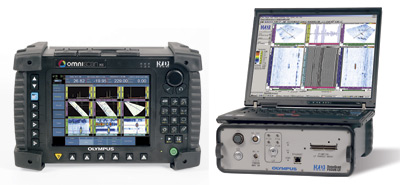Introduction to Phased Array Equipment
Phased array ultrasonic testing is a form of nondestructive testing that features a multielement transducer capable of pulsing at different intervals and in multiple directions simultaneously.
Phased Array Equipment

As with other categories of ultrasonic test equipment, phased array systems are available in a variety of models with increasing complexity and capability. Instruments range from basic models that perform simple sector and linear scans with 16-element probes to advanced systems that offer multichannel capability and advanced interpretive software with probes of up to 256 elements. Find more information on our line of phased array equipment here.
What is a Phased Array Transducer?
An array transducer is one that contains a number of separate elements in a single housing, and phasing refers to how those elements are sequentially pulsed. A phased array system is normally based around a specialized ultrasonic transducer that contains many individual elements (typically from 16 to 256) that can be pulsed separately in a programmed pattern. These transducers can be used with various types of wedges, in a contact mode, or in immersion testing. Their shape may be square, rectangular, or round, and test frequencies are commonly in the range of 1–10 MHz. The following sections of this tutorial provide more information about phased array probes.
What Do Phased Arrays Do?
Phased array systems pulse and receive from multiple elements of an array. These elements are pulsed to cause multiple beam components to combine with each other and form a single wave front traveling in the desired direction. Similarly, the receiver function combines the input from multiple elements into a single presentation. Because phasing technology permits electronic beam shaping and steering, it is possible to generate a vast number of different ultrasonic beam profiles from a single probe assembly, and this beam steering can be dynamically programmed to create electronic scans.
This enables the following capabilities:
- Software control of beam angle, focal distance, and beam spot size. These parameters can be dynamically scanned at each inspection point to optimize incident angle and signal-to-noise for each part geometry.
- Multiple-angle inspection can be performed with a single, small, multielement probe and wedge, offering either single fixed angles or a scan through a range of angles.
- These capabilities provide greater flexibility for inspection of complex geometries and tests where part geometry limits access.
- Multiplexing across many elements enables motionless high-speed scans from a single transducer position. More than one scan can be performed from a single location with various inspection angles.